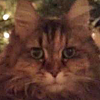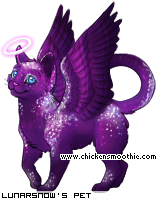Share your real pet photos and stories, tell us about your fav species, promote wildlife causes, or discuss animal welfare
 by Thalassic » Sat Nov 05, 2016 6:34 am
by Thalassic » Sat Nov 05, 2016 6:34 am
Tepin. wrote:I have been to a couple of shelters in my area. As I said that is probably the way I will go, I'd love to give a shelter kitty a good home. It just hurts me to have to leave my other cat, though I know it is the right decision. I do have a deep connection with that cat, but I will what is best for her. My parents do not mind, and she is happy . I am the looser in that respect. I know that i will always love her though, and I am sure I can form a bond with another cat .. I just feel like a traitor as I said before xP Me just being silly.
Nah I totally get what you mean.
I found my second cat literally out on the street. He was a tiny sick kitten and I just couldn't leave him there, so I brought him home. And for the first couple months I felt like I was betraying the cat I already had. He's always lived alone and never liked the neighbor cats, and for a while he seemed really mad at me for bringing this stranger into his territory. I had doubts about the kitten because I didn't know how upset it would make my cat.
It's now been about 6 months since the kitten has been home with us, and they tolerate eachother. And honestly, that's all I could ever ask for. They still get into small fights every once in a while, as the kitten is very active and playful, and the old cat is an old grumpy man, but I don't regret what I did. I probably saved the kittens life, and my old cat is back to his cuddly old self.
The way you feel is completely valid, but just because you're getting a new home, doesn't mean your cat has to get a new home as well. Her home is with your parents, and I'm sure you could still visit her and she'd still recognize you. But this could be a great chance to give another cat a loving home. And let me tell you, it's hard to not fall in love with a cat. I'm sure you'll form a great bond with them. c:
xxxxx✦ xxxxxxxxxxxxxx✦xxxxxxxxxxxxxx ✦xxxxxxxxxx
x
x
x
x
xxxx✦
x
x
x
x
xxxxxxxx✦
x
x
xxx✦
x
xxxxxxx✦
xxxxxxxxxx
x
x
x
x
xxxx✦
x
x
x
x
✦xxxxxxxx
x
x
xxxxxx✦
x
✦xxxxxxx
-

Thalassic
-
- Posts: 13128
- Joined: Sun Apr 11, 2010 6:11 am
- My pets
- My items
- My wishlist
- My gallery
- My scenes
- My dressups
- Trade with me
-
 by Rachley » Sat Nov 05, 2016 11:09 am
by Rachley » Sat Nov 05, 2016 11:09 am
ru. wrote:ru. wrote:Both of the kittens I showed pictures of from Litter 2 were Male. The shorthaired ticked tabby was a male (my personal cat, Talbot. RIP. :c).
This is the Litter that I have been most curious about.
Our theory was that the father must have been a brown/black shorthaired tabby (as half of the kittens were shorthaired).
If males only get color genes from the mother, how did this brown/black ticked tabby male come to be? He was the only brown (and non-grey) tabby in the entire litter. Is it possible that the mother carried the gene, or something?
I'm still extremely curious about this. Can anyone explain this to me? :0
This idea that male kittens get base color genes only from their mother is completely new to me, so I'm just tryin' to learn, haha
Sorry for your loss. :c
I'm curious about this as well, and I have a very similar story! Eight years ago, my neighbor's cat had kittens. The mother was solid gray, and we didn't know the father. Every kitten in the litter was a gray tabby, except for one brown tabby male. We assumed the father was a brown tabby. My family and I ended up adopting one of the gray tabby kittens. c:
 • ❆ • ❅ • ❆ • ❅ • ❆ •adult user | friendly | walrus obsessed | christian | enjoys meditation
• ❆ • ❅ • ❆ • ❅ • ❆ •adult user | friendly | walrus obsessed | christian | enjoys meditation
-

Rachley
-
- Posts: 2321
- Joined: Tue Aug 26, 2008 9:11 pm
- My pets
- My items
- My wishlist
- My gallery
- My scenes
- My dressups
- Trade with me
 by blazesong » Sat Nov 05, 2016 11:41 am
by blazesong » Sat Nov 05, 2016 11:41 am
Rachley wrote:ru. wrote:ru. wrote:Both of the kittens I showed pictures of from Litter 2 were Male. The shorthaired ticked tabby was a male (my personal cat, Talbot. RIP. :c).
This is the Litter that I have been most curious about.
Our theory was that the father must have been a brown/black shorthaired tabby (as half of the kittens were shorthaired).
If males only get color genes from the mother, how did this brown/black ticked tabby male come to be? He was the only brown (and non-grey) tabby in the entire litter. Is it possible that the mother carried the gene, or something?
I'm still extremely curious about this. Can anyone explain this to me? :0
This idea that male kittens get base color genes only from their mother is completely new to me, so I'm just tryin' to learn, haha
Sorry for your loss. :c
I'm curious about this as well, and I have a very similar story! Eight years ago, my neighbor's cat had kittens. The mother was solid gray, and we didn't know the father. Every kitten in the litter was a gray tabby, except for one brown tabby male. We assumed the father was a brown tabby. My family and I ended up adopting one of the gray tabby kittens. c:
hair isnt a sex linked trait i belive and short hair is dominate to long hair.
now when you say 'brown' tabby do you mean the stripes where brown?
if no then they had a black tabby.
your neighbors girl was grey but only hade one dilute gene, all the kittens got it but the male
i need a new signature
Lights :off
-

blazesong
-
- Posts: 20597
- Joined: Sun Feb 28, 2010 10:56 am
- My pets
- My items
- My wishlist
- My gallery
- My scenes
- My dressups
- Trade with me
 by Lunarsnow » Sat Nov 05, 2016 11:42 am
by Lunarsnow » Sat Nov 05, 2016 11:42 am
On the topic of genes! #1 in the following list is relevant to the current argument/conversation.
Taken from the Cat Fanciers' Association:
The following statements are generally true but there are exceptions. This information is not meant to be a complete manual on cat genetics. For more information, please refer to books on the subject.
When the term COLOR is used, it refers to color only (blue, cream, black, red, etc.). When PATTERN is used, it refers to pattern only (tabby, shaded, smoke, etc.). When both are affected, the statement will contain the term COLOR/PATTERN.
- 1. Male kittens always obtain both color genes from the dam (mother).The male offspring in a litter will always be either the color of the dam (or one of the colors in the case of parti-colors) or the dilute form of the dam's color. See the statement on dilutes for more information (see #21 & #24).
- 2. Female kittens take one color gene from each parent. The color of the female kittens in a litter will always be either a combination of the sire's and dam's colors, or the dilute form of those colors (see #21 & #24).
- 3. To obtain any of the red or cream color/patterns in female kittens, the sire must be one of the red or cream color/patterns PLUS the dam must in some form demonstrate red or cream (see #21).
- 4. Only the immediate parents determine the color/pattern of a kitten. The color/patterns found in the pedigree of a kitten will NOT always directly affect the color/pattern of the kitten. One notable exception is the colorpoint gene, which can carry through a number of generations (see #21 & #24).
- 5. A kitten's pattern can be inherited from either parent.
- 6. A dominant characteristic (all dominant colors and patterns such as shaded, smoke, white, tabby, bi-color, etc.) cannot skip generations. The characteristic cannot be transmitted from one generation to the next without showing that characteristic in each generation.
- 7. A cat displaying a dominant color (black, red, tortie, etc.) must have a parent which displays a dominant color (see #21).
- 8. Two recessive color parents (cream, blue, etc.) cannot produce an offspring of a dominant color (black, red, etc.).
- 9. Two colorpointed parents cannot produce a non-colorpointed offspring.
- 10. To get a colorpointed kitten, both parents must be carrying the colorpointed gene (even if they do not appear colorpointed themselves).
- 11. The mating of a colorpointed cat and a cat with no colorpointed background will produce NO colorpointed offspring.
- 12. A (non-silver) tabby must have at least one parent that is either a shaded or a tabby. A silver tabby must have at least one silver tabby, shaded or smoke parent (see #13).
- 13. All red cats will have some tabby markings. Whether or not a red can produce as a tabby will depend on whether it is a true tabby with a tabby or shaded parent or whether it is a red with ghost tabby markings and neither a tabby nor a shaded parent. A red tabby that is not a true tabby cannot produce a tabby offspring of any other color without being bred to a true tabby or a shaded.
- 14. A cat with a white undercoat (smoke or shaded) must have a parent that has a white undercoat (see #21).
- 15. A shaded cat must have at least one parent that is a shaded (see #21).
- 16. A shaded parent can produce a smoke offspring, but a non-shaded (smoke) parent cannot produce a shaded offspring unless bred to a shaded (see #21).
- 17. A bi-color must have a bi-color parent (see #21).
- 18. Parti-color cats (blue-cream, tortie, calico) are almost always female, but males can and do occur occasionally (and are not always sterile).
- 19. A white cat must have a white parent.
- 20. A white cat breeds as both a white (which you see) and a masked color (which you don't see) and can produce based on both white and the unseen color/pattern. The masked color/pattern must be determined, based on the white's pedigree and the offspring produced in a controlled breeding, in order to effectively predict the color/pattern of the expected offspring. Interestingly, white kittens may have a small spot of color on top of their heads when born. This color should be noted as it is the color that the white is masking and the color that the cat will breed as when an adult. The spot of color may be visible for several months, but often disappears as the kitten matures.
- 21. Genetics for solid white cats can affect the possible color/pattern of expected kittens in that the white parent may be masking the color/pattern needed to produce this result.
- 22. Two longhair parents cannot produce a shorthair kitten.
- 23. Two classic tabby parents cannot produce a mackerel, spotted, or ticked tabby kitten. A ticked tabby must have a ticked tabby parent. A mackerel or spotted tabby must have a mackerel, spotted, or ticked tabby parent (see #21).
- 24. The dilute gene must be present in both the sire and dam's pedigree in order to produce a dilute offspring.
- 25. The chocolate or lilac gene must be present in both the sire and dam's pedigree in order to produce chocolate or lilac offspring.

Random cat spotlight <3
-

Lunarsnow
-
- Posts: 5398
- Joined: Sun Feb 23, 2014 5:03 am
- My pets
- My items
- My wishlist
- My gallery
- My scenes
- My dressups
- Trade with me
 by ru. » Sat Nov 05, 2016 12:03 pm
by ru. » Sat Nov 05, 2016 12:03 pm
@Lunarsnow
Also @blazesong @Rachley
I actually did a quick google search yesterday and found the page with that article as well! It's very informative! c: Thank you for sharing.
I'm still a little bit stuck on "Litter 2" that I posted, however. I couldn't find anything mentioning anything similar to my particular situation (of my understanding, at least).
Summary here (photos a few pages back):
>A blue mackerel tabby female gave birth to a litter of kittens by an unknown father.
>Most of the kittens were also blue (some solid, some mackerel tabby, 1 female blue ticked tabby)
>One kitten was a male black (brown) ticked tabby. (Yes, I am 100% sure that he was a male, as I had him neutered)
My understanding is that base color genes must be either the color or the dilute of the color of a parent. It is also my understanding that males get their base color from the mother.
That being said, how does this work in this litter? How is he black & brown? How did he get a brown coat with black stripes if the mother was grey/blue?
Am I missing something here?
(I also have more pictures of the male black/brown tabby in question, if needed).
| INFJ | Capricorn | Blood Type B | Coyote Dæmon | Neutral Good | Creative Type |
-

ru.
-
- Posts: 6602
- Joined: Fri Mar 13, 2009 4:44 pm
- My pets
- My items
- My wishlist
- My gallery
- My scenes
- My dressups
- Trade with me
 by Thalassic » Sat Nov 05, 2016 12:34 pm
by Thalassic » Sat Nov 05, 2016 12:34 pm
Lunarsnow wrote: - 1. Male kittens always obtain both color genes from the dam (mother).The male offspring in a litter will always be either the color of the dam (or one of the colors in the case of parti-colors) or the dilute form of the dam's color. See the statement on dilutes for more information (see #21 & #24).
[/quote]
I'm a bit confused by this.
My cat is what's called a classic tabby (I think? brownish with black stripes) with some white on him, he's a male but his mother was plain grey with some white. There was another kitten in the litter who was black and white, but we didn't find out their gender.
So how would a grey moms genes lead to a brown tabby with stripes?
xxxxx✦ xxxxxxxxxxxxxx✦xxxxxxxxxxxxxx ✦xxxxxxxxxx
x
x
x
x
xxxx✦
x
x
x
x
xxxxxxxx✦
x
x
xxx✦
x
xxxxxxx✦
xxxxxxxxxx
x
x
x
x
xxxx✦
x
x
x
x
✦xxxxxxxx
x
x
xxxxxx✦
x
✦xxxxxxx
-

Thalassic
-
- Posts: 13128
- Joined: Sun Apr 11, 2010 6:11 am
- My pets
- My items
- My wishlist
- My gallery
- My scenes
- My dressups
- Trade with me
-
 by Lunarsnow » Sat Nov 05, 2016 1:19 pm
by Lunarsnow » Sat Nov 05, 2016 1:19 pm
ru. wrote:
>A blue mackerel tabby female gave birth to a litter of kittens by an unknown father.
>Most of the kittens were also blue (some solid, some mackerel tabby, 1 female blue ticked tabby)
>One kitten was a male black (brown) ticked tabby. (Yes, I am 100% sure that he was a male, as I had him neutered)
My understanding is that base color genes must be either the color or the dilute of the color of a parent. It is also my understanding that males get their base color from the mother.
That being said, how does this work in this litter? How is he black & brown? How did he get a brown coat with black stripes if the mother was grey/blue?
Am I missing something here?
(I also have more pictures of the male black/brown tabby in question, if needed).
Cataclasm wrote:Lunarsnow wrote: - 1. Male kittens always obtain both color genes from the dam (mother).The male offspring in a litter will always be either the color of the dam (or one of the colors in the case of parti-colors) or the dilute form of the dam's color. See the statement on dilutes for more information (see #21 & #24).
I'm a bit confused by this.
My cat is what's called a classic tabby (I think? brownish with black stripes) with some white on him, he's a male but his mother was plain grey with some white. There was another kitten in the litter who was black and white, but we didn't find out their gender.
So how would a grey moms genes lead to a brown tabby with stripes?
Most cats that people call brown tabbies are actually black tabbies! Similar to how black cats may have a brown shine in the sunlight. Blue is a dilute form of black and brown is a black-based color. Here's an explanation I found: "In particular, the Brown Tabby patterns are genetically Black, but the selection of individuals with strong rufousing has produced a rich brown color in the ticked hairs."
[x]He got his stripes from the unknown papa cat and the coloration is just very brown tinted even though his genes will most likely tell you he's got the black gene.
All that said correct me if I'm wrong! I'm by no means an expert on cat genetics, it's just something I'm interested in and look up a lot. ^^

Random cat spotlight <3
-

Lunarsnow
-
- Posts: 5398
- Joined: Sun Feb 23, 2014 5:03 am
- My pets
- My items
- My wishlist
- My gallery
- My scenes
- My dressups
- Trade with me
 by Rachley » Sat Nov 05, 2016 2:10 pm
by Rachley » Sat Nov 05, 2016 2:10 pm
Interesting information, although I still find it confusing, haha.
It's very interesting how complex a cat's coloring is, and the genetics behind it. My gray tabby has a faint tan color in some areas. I've also noticed in my orange/red tabby, that he has a bit of white or cream fur in some areas, like throughout his tail, the fur between his paws, his belly, and a tiny white patch on his chest. It's very slight, and you can only notice it when the sun shines in through the windows. Otherwise, he looks completely orange with red stripes. Another thing, is that my gray tabby has bold green eyes with a few brown dots. Also, after having my cream/tan cat for a year, I just noticed something. His nose is a darker pink at the top, which spots into a lighter pink at the bottom. It's very interesting to notice these subtle details, and it adds to their unique-ness.
 • ❆ • ❅ • ❆ • ❅ • ❆ •adult user | friendly | walrus obsessed | christian | enjoys meditation
• ❆ • ❅ • ❆ • ❅ • ❆ •adult user | friendly | walrus obsessed | christian | enjoys meditation
-

Rachley
-
- Posts: 2321
- Joined: Tue Aug 26, 2008 9:11 pm
- My pets
- My items
- My wishlist
- My gallery
- My scenes
- My dressups
- Trade with me
Who is online
Users browsing this forum: No registered users and 8 guests









